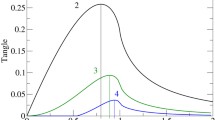Abstract
Classical phase transitions occur when a physical system reaches a state below a critical temperature characterized by macroscopic order1. Quantum phase transitions occur at absolute zero; they are induced by the change of an external parameter or coupling constant2, and are driven by quantum fluctuations. Examples include transitions in quantum Hall systems3, localization in Si-MOSFETs (metal oxide silicon field-effect transistors; ref. 4) and the superconductor–insulator transition in two-dimensional systems5,6. Both classical and quantum critical points are governed by a diverging correlation length, although quantum systems possess additional correlations that do not have a classical counterpart. This phenomenon, known as entanglement, is the resource that enables quantum computation and communication8. The role of entanglement at a phase transition is not captured by statistical mechanics—a complete classification of the critical many-body state requires the introduction of concepts from quantum information theory9. Here we connect the theory of critical phenomena with quantum information by exploring the entangling resources of a system close to its quantum critical point. We demonstrate, for a class of one-dimensional magnetic systems, that entanglement shows scaling behaviour in the vicinity of the transition point.




Similar content being viewed by others
References
Goldenfeld, N. Lectures on Phase Transitions and the Renormalization Group (Addison Wesley, New York, 1992).
Sachdev, S. Quantum Phase Transitions (Cambridge Univ. Press, Cambridge, 2000).
Sondhi, S. I., Girvin, S. M., Carini, J. P. & Shahar, D. Continuous phase transitions. Rev. Mod. Phys. 69, 315–333 (1997).
Kravchenko, S. V., Kravchenko, G. V., Furneaux, J. E., Pudalov, V. M. & D'Iorio, M. Possible metal-insulator transition at B=0 in two dimensions. Phys. Rev. B 50, 8039–8042 (1994).
Haviland, D. B., Liu, Y. & Goldman, A. M. Onset of superconductivity in the two-dimensional limit. Phys. Rev. Lett. 62, 2180–2183 (1989).
van der Zant, H. S. J., Fritschy, F. C., Elion, W. E., Geerligs, L. J. & Mooij, J. E. Field-induced superconductor-to-insulator transition in Josephson junction arrays. Phys. Rev. Lett. 69, 2971–2974 (1992).
Bell, J. S. Speakable and Unspeakable in Quantum Mechanics (Cambridge Univ. Press, Cambridge, 1987).
Nielsen, M. & Chuang, I. Quantum Computation and Quantum Communication (Cambridge Univ. Press, Cambridge, 2000).
Preskill, J. Quantum information and physics: some future directions. J. Mod. Opt. 47, 127–137 (2000).
Brooke, J., Bitko, D., Rosenbaum, T. F. & Aeppli, G. Quantum annealing of a disordered spin system. Science 284, 779–781 (1999).
O'Connors, K. M. & Wootters, W. K. Entangled rings. Phys. Rev. A 63, 052302-1–052302-9 (2001).
Dür, W., Vidal, G. & Cirac, J. I. Three qubits can be entangled in two inequivalent ways. Phys. Rev. A 62, 062314-1–062314-12 (2000).
Wang, X. Entanglement in the quantum Heisenberg XY model. Phys. Rev. A 64, 012313-1–012313-7 (2001).
Arnesen, M. C., Bose, S. & Vedral, V. Natural thermal and magnetic entanglement in the 1D Heisenberg model. Phys. Rev. Lett. 87, 017901-1–017901-4 (2001).
Gunlycke, D., Bose, S., Kendon, V. M. & Vedral, V. Thermal concurrence mixing in a 1D Ising model. Phys. Rev. A 64, 042302-1–042302-7 (2001).
Osborne, T. J. & Nielsen, M. A. Entanglement, quantum phase transitions, and density matrix renormalization.Preprint quant-ph/0109024 at 〈http://xxx.lanl.gov〉 (2001).
Pfeuty, P. The one-dimensional Ising model with a transverse field. Ann. Phys. 57, 79–90 (1970).
Barouch, E. & McCoy, B. M. Statistical mechanics of the XY model. II Spin-correlation functions. Phys. Rev. A 3, 786–804 (1971).
Bennett, C. J., Bernstein, H. J., Popescu, S. & Schumacher, B. Concentrating partial entanglement by local operations. Phys. Rev. A 53, 2046–2052 (1996).
Vedral, V., Plenio, M. B., Rippin, M. A. & Knight, P. Quantifying entanglement. Phys. Rev. Lett. 78, 2275–2279 (1997).
Bennett, C. H., DiVincenzo, D. P., Smolin, J. & Wootters, W. K. Mixed-state entanglement and quantum error correction. Phys. Rev. A 54, 3824–3851 (1996).
Wootters, W. K. Entanglement of formation of an arbitrary state of two qubits. Phys. Rev. Lett. 80, 2245–2248 (1998).
Lieb, E., Schultz, T. & Mattis, D. Two soluble models in antiferromagnetic chain. Ann. Phys. 60, 407–466 (1961).
Barber, M. N. in Phase Transitions and Critical Phenomena Vol. 8 (eds Domb, C. & Leibovitz, J. L.) 146–259 (Academic, London, 1983).
Acknowledgements
We thank G.M. Palma, F. Plastina and J. Siewert for discussions. This work was supported by the European Community (IST-SQUBIT) and by INFM-PRA-SSQI.
Author information
Authors and Affiliations
Corresponding author
Ethics declarations
Competing interests
The authors declare that they have no competing financial interests
Rights and permissions
About this article
Cite this article
Osterloh, A., Amico, L., Falci, G. et al. Scaling of entanglement close to a quantum phase transition. Nature 416, 608–610 (2002). https://doi.org/10.1038/416608a
Received:
Accepted:
Issue Date:
DOI: https://doi.org/10.1038/416608a
- Springer Nature Limited
This article is cited by
-
Long distance entanglement and high-dimensional quantum teleportation in the Fermi–Hubbard model
Scientific Reports (2023)
-
Efficient quantum information probes of nonequilibrium quantum criticality
npj Quantum Information (2023)
-
Shortcuts to adiabaticity in superconducting circuits for fast multi-partite state generation
Communications Physics (2023)
-
Entanglement entropy as an order parameter for strongly coupled nodal line semimetals
Journal of High Energy Physics (2023)
-
Quantum Entanglement in Heisenberg Model with Dzyaloshinskii-Moriya Interactions
Journal of Superconductivity and Novel Magnetism (2023)





